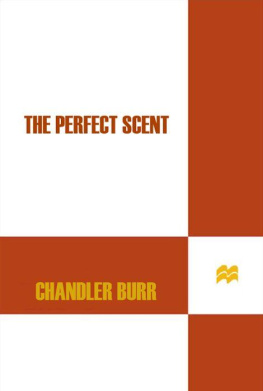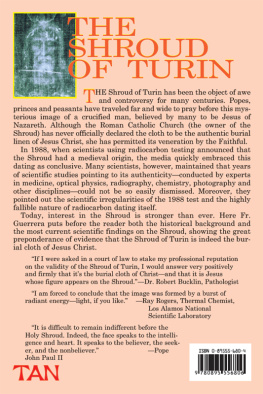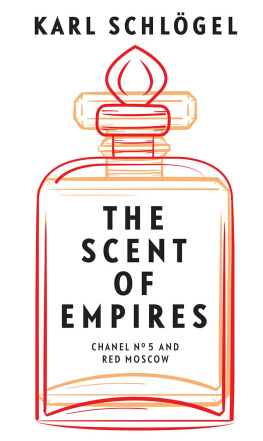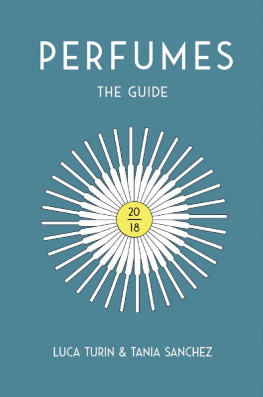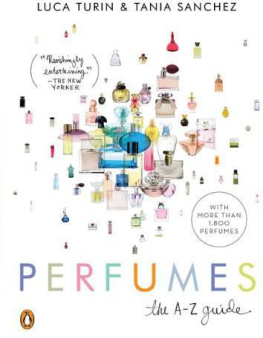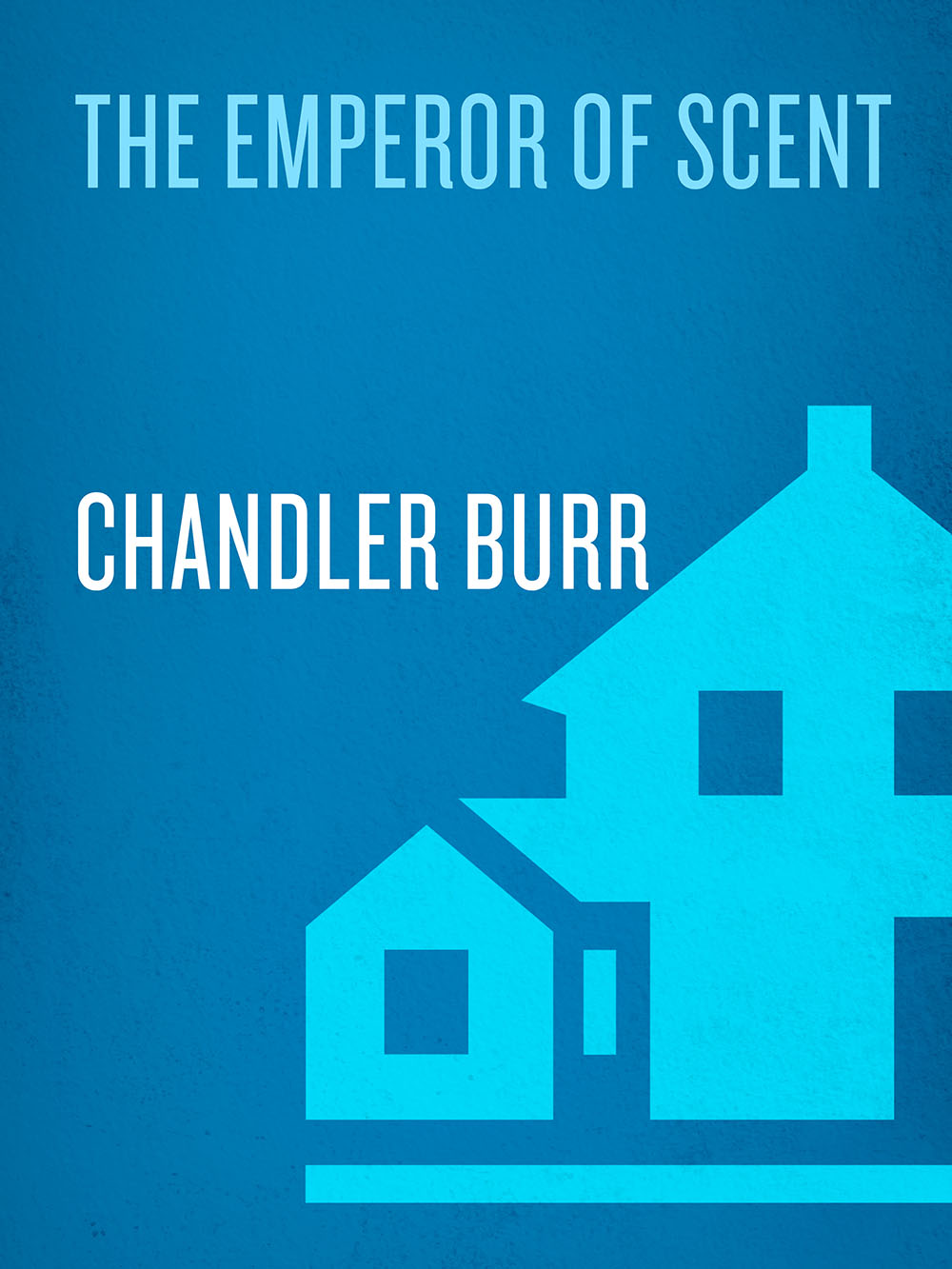
THE
EMPEROR
OF
SCENT
A STORY OF PERFUME, OBSESSION,
AND THE LAST MYSTERY
OF THE SENSES
CHANDLER BURR

RANDOM HOUSE / NEW YORK
Copyright 2002 by Chandler Burr
All rights reserved under International and Pan-American
Copyright Conventions. Published in the United States by Random House, Inc.,
New York, and simultaneously in Canada by Random House
of Canada Limited, Toronto.
RANDOM HOUSE and colophon are registered trademarks
of Random House, Inc.
Grateful acknowledgment is made to Rutgers University Press for permission to reprint excerpts from Ignition, by John D. Clark. Copyright 1972 by Rutgers, The State University. Reprinted by permission of Rutgers University Press.
All the illustrations in this work were drawn by Marie Guibert, excluding the drawings of musical notes on page 26, which were done by Christopher J. Mossey, and the drawing of the molecular shapes of ferrocene and nickelocene
on page 106, which was done by Luca Turin. All illustrations
are used by permission of the individual artists.
Library of Congress Cataloging-in-Publication Data
Burr, Chandler.
The emperor of scent : a story of perfume, obsession,
and the last mystery of the senses / Chandler Burr.
p. cm.
1. Turin, Luca. 2. Smell. 3. Nose.
4. BiophysicistsGreat BritainBiography.
I. Title.
QP458 .B83 2002
612.86dc21 2002023697
Random House website address: www.atrandom.com
eISBN: 978-1-58836-260-5
v3.0_r1
CONTENTS
I should think that we might fairly gauge the future of biological science, centuries ahead, by estimating the time it will take to reach a complete comprehensive understanding of odor. It... contains, piece by piece, all the mysteries.
LEWIS THOMAS
A NOTE FROM THE AUTHOR
For the sake of scientific and narrative clarity, I have edited certain e-mails and correspondence and presented some events out of order. Some names and details have been changed to protect privacy.
PART
I
CREATION
I
MYSTERY
START WITH THE deepest mystery of smell. No one knows how we do it.
Despite everything, despite the billions the secretive giant corporations of smell have riding on it and the powerful computers they throw at it, despite the most powerful sorcery of their legions of chemists and the years of toiling in the labs and all the famous neurowizardry aimed at mastering it, the exact way we smell thingsanything, crushed raspberry and mint, the subway at West Fourteenth and Eighth, a newborn infantremains a mystery. Luca Turin began with that mystery.
Or perhaps he began further back, with the perfumes. The reason I got into this, Turin will say, is that I started collecting perfume. Ive loved perfume from when I was a kid in Paris and Italy.
Or maybe (hell tell you another day, considering it from a different angle), maybe it was because Im French, at least by upbringing. Frenchmen will do things Anglo men wont, and France is a country of smells. Theres something called pourriture noble. Noble rot. Its a fungus. It grows on grapes, draws the water out, concentrates the juice wonderfully, adds its own fungal flavor, and then you make wines like the sweet Sauternes. Paradise. From rotten grapes. The idea that things should be slightly dirty, overripe, slightly fecal is everywhere in France. They like rotten cheese and dirty sheets and unwashed women. Guy Robert is about seventy, a third-generation perfumer, lives in the south of France, used to work for International Flavors & Fragrances, created Calche for Herms. One day he asked me, Est-ce que vous avez senti some molecule or other? And I said no, Id never smelled it, whatd it smell like? And he considered this gravely and replied, a sent la femme qui se nglige. (It smells of the woman who neglects herself.)
This makes him remember something, and he leans forward enthusiastically. One of the stories I heard when I started meeting the perfumers and was let into their tightly closed world involves Jean Carles, one of the greatest perfume makers in Parishe used to work for Roure in Grasse, near Nice, where all perfumes used to be made. He became anosmic, lost his sense of smell, and he simply carried on from memory, creating perfumes. Like Beethoven after his deafness. Jean Carles went on to create the great Ma Griffe for Carven, a result of pure imagination in the complete absence of the relevant physical sense. Carless condition was known only to him and his son. When a client came in, hed go through the motions, make a big show of smelling various ingredients and, finally, the perfume he had created, which he would present with great gravity to the client, smelling it and waving its odor around the room. And he couldnt smell anything! Turin smiles, thinking about it.
The perfume obsession led Turin to write the perfume guide, which out of the blue cracked open for him doors into the vast, secret world in which perfumes are created, and there he started noticing little things that didnt make sense. A weird warp in official reality. Plus there were the other clues, the small pockets of strangeness he bumped into in the scientific literature, carefully fitting these into the puzzle without even realizing it, without (as hed be the first to admit) really understanding what he was doing. And somewhere along the line, between scouring the French Riviera for bottles of buried fragrances, pursuing (in his own very particular way) the strange triplets of biology and chemistry and physics, and prowling the librarys remotest stacks, randomly sliding into things he found theresomething that due to his intellectual promiscuity he does a lot ofsomewhere Luca Turin got the idea of cracking smell. But it started with the mystery at smells heart, which is not only that we dont know how we do it. We actually shouldnt be able to smell at all.
FROM EVERYTHING WE know about evolution and molecular biology, smell does the impossible. Look at two other systems inside your body, and youll understand.
First, digestion. Human beings have evolved over millennia while eating certain moleculeslipids and carbohydrates and proteins in the roots and berries and various unlucky animals weve gotten our hands on. The tiny carbs and proteins are made of tinier atoms and molecules, and for your body to burn them as various fuels, evolution has engineered a digestive system for you. The systems first task is to recognize which raw fuel its dealing with, so it can send out the right enzymes to break that fuel down, process it for us. (Enzymes are catalysts, molecule wranglers, and every enzyme in every one of our cellsand there are tens of thousands of different enzymesbinds to a molecule and processes it. Some break molecules down, scrapping them to use their dismantled parts, some zip them together, and some rearrange them for the bodys own purposes.) But in every case the enzyme recognizes its molecule by that molecules particular shape. Fat, thin, lumpy, rounded, oblong, rectangular. The enzyme feels some cleft in some molecule, fits its special fingers into it like a key fits into a lock. And if the shape of the lock and the shape of the key conform, bingo: Recognition! By shape.
And what gives a molecule its shape? We think of atoms as these perfectly symmetrical spheres, shining and frozen on labels of Super-Strong! kitchen cleaners, their electrons zipping around their nuclei like perfectly spherical stainless-steel bracelets. Since electrons move at close to the speed of light, if you filmed those cartoon atoms in motion youd see a round electron membrane, a solid, buzzing sphere made of blisteringly fast-moving electrons.
Next page

